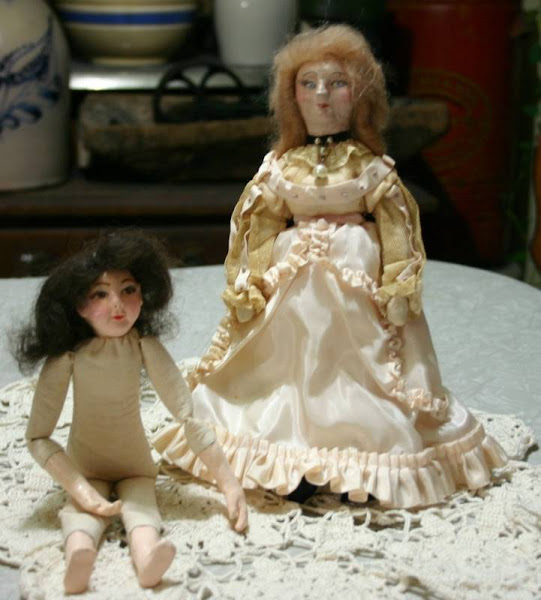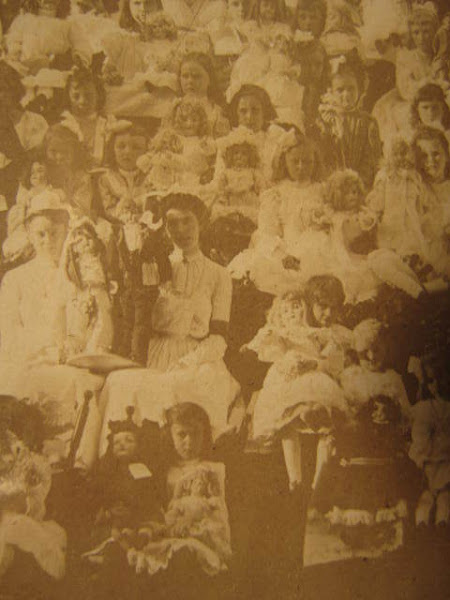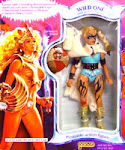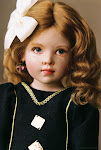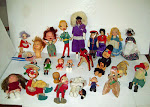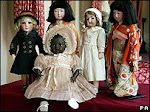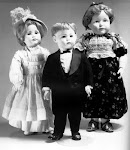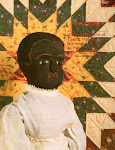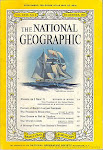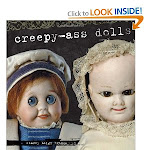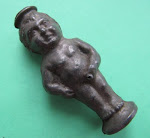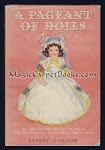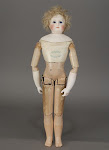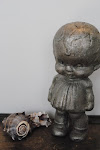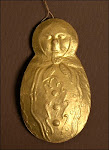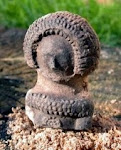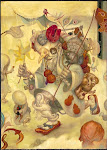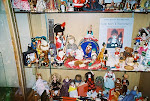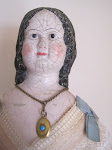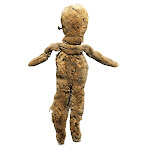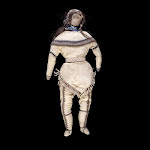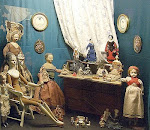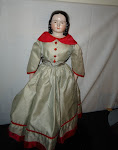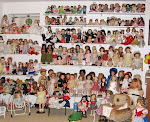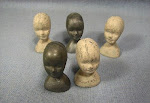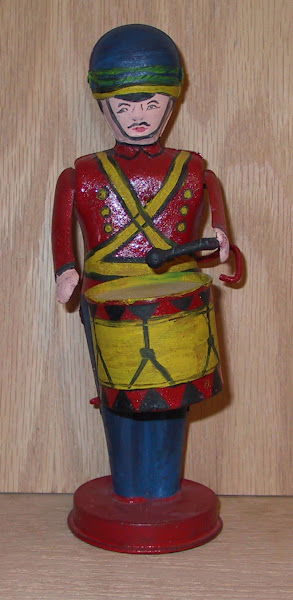My good friends at a local Lutheran Church invited me once more to their wonderful All Daughters Banquet last night. As usual, it was terrific. The speaker had a fantastic colletion of hats and head coverings, including books, scarves, hair nets, fun hats, you name it. Each had its story, as any good collectible should, and she mentioned she also had dolls that wore some of the hats. Same as me. Vintage fashion and doll collections go very well together. I plan to display my vintage clothing and accessories in the brick/mortar museum. Often, the dolls and their constumes are the last vestiges of the fashion history of an era; they are the 3-D encyclopedias left to us, and fashion dolls were sent around as the silent envoys of couture to anyone who could afford them.
I plan to be on a local TV show next week; gulp! I am gathering historical dolls and memorabilia and found a photo of the wooden stump down, allegedly a once-loved toy of Edward VI, the prince in The Prince and the Pauper, and Henry VIII's son. It was part of the legendary Helen Moe Doll Musem, and I saw it Paso Robles, CA, where I also bought a dolls parasol and Jan Hagara figurine. She had a lead doll, too, that I was supposed to get to photograph; Ah, the best laid plans of mice and girls.
Hope all is well with everyone; God hel the People of the South and of Alabama. I spent several great summer trips down south, and many of our dolls came from southern antique stores and wonderful museum shops. Till later, Happy Dolling!
Saturday, April 30, 2011
Thursday, April 28, 2011
Baudelaire and "A Philosophy of Toys."
artículo
Baudelaire, Charles
A Philosophy of Toys
Brandon Lattu. Alll Toys , 2006
Many years ago I was taken by my mother to visit a certain Madame Panckoucke. (…) I remember very clearly that this lady was clad in velvet and fur. At the end of a short time, she said: ‘Here we have a little boy whom I would like to give something to – to remember me by.’ She took me by the hand and we passed through several rooms; then she opened the door of a chamber where an extraordinary and truly fairylike spectacle met my gaze. The walls were literally invisible, so covered were they with toys. The ceiling had vanished behind an efflorescence of toys which hung from it like marvellous stalactites. On the floor was hardly a narrow catwalk to place one’s feet upon. It was a whole world of toys of all kinds, from the most costly to the most trifling, from the simplest to the most complicated.
‘This,’ said she, ‘is the children’s treasury. I regularly set aside a small sum of money to add to it, and when a nice little boy comes to see me, I bring him here so that he can take away a souvenir of me. Make your choice.’ With admirable and luminous alacrity which is typical of children, in whose minds desire, deliberation and action make up, so to speak, but a single faculty – a fact which distinguishes them from degenerate man, with whom, in contrast, deliberation absorbs almost the whole of his time – I seized hold of the most beautiful, the most expensive, the most showy, the newest, the most unusual of the toys. My mother protested against my impertinence and obstinately refused to let me take it away with me. She wanted me to be content with an infinitely ordinary object. But I could not agree, and to make everything all right, resigned myself to a fair compromise.
Alice Anderson. Still Life, 2006
It has often struck me that it would be amusing to know all the ‘nice little boys’ who have now crossed a good part of life’s cruel desert and have for a long time been handling something other than toys, and yet whose carefree childhood once upon a time took away a souvenir from Madame Panckoucke’s treasury. This episode is responsible for my never being able to stop in front of a toyshop and run my eyes over the inextricable muddle of strange shapes and clashing colours of its contents without thinking of the velvet-and-fur-clad lady who appeared to me as the Toy Fairy. I have moreover retained a lasting affection and a reasoned admiration for that strange statuary art which, with its lustrous neatness, its blinding flashes of colour, its violence in gesture and decision of contour, represents so well childhood’s idea about beauty. There is an extraordinary gaiety in a great toyshop which makes it preferable to a fine bourgeois apartment. Is not the whole of life to be found there in miniature – and far more highly coloured, sparkling and polished than real life? There we see gardens, theatres, beautiful dresses, eyes pure as diamonds, cheeks ablaze with rouge, charming lace, carriages, stables, cattle-sheds, drunkards, charlatans, bankers, actors, punchinellos like foreworks, kitchens, and whole armies, in perfect discipline, with cavalry and artillery. (...)
Baudelaire, Charles
A Philosophy of Toys
Brandon Lattu. Alll Toys , 2006
Many years ago I was taken by my mother to visit a certain Madame Panckoucke. (…) I remember very clearly that this lady was clad in velvet and fur. At the end of a short time, she said: ‘Here we have a little boy whom I would like to give something to – to remember me by.’ She took me by the hand and we passed through several rooms; then she opened the door of a chamber where an extraordinary and truly fairylike spectacle met my gaze. The walls were literally invisible, so covered were they with toys. The ceiling had vanished behind an efflorescence of toys which hung from it like marvellous stalactites. On the floor was hardly a narrow catwalk to place one’s feet upon. It was a whole world of toys of all kinds, from the most costly to the most trifling, from the simplest to the most complicated.
‘This,’ said she, ‘is the children’s treasury. I regularly set aside a small sum of money to add to it, and when a nice little boy comes to see me, I bring him here so that he can take away a souvenir of me. Make your choice.’ With admirable and luminous alacrity which is typical of children, in whose minds desire, deliberation and action make up, so to speak, but a single faculty – a fact which distinguishes them from degenerate man, with whom, in contrast, deliberation absorbs almost the whole of his time – I seized hold of the most beautiful, the most expensive, the most showy, the newest, the most unusual of the toys. My mother protested against my impertinence and obstinately refused to let me take it away with me. She wanted me to be content with an infinitely ordinary object. But I could not agree, and to make everything all right, resigned myself to a fair compromise.
Alice Anderson. Still Life, 2006
It has often struck me that it would be amusing to know all the ‘nice little boys’ who have now crossed a good part of life’s cruel desert and have for a long time been handling something other than toys, and yet whose carefree childhood once upon a time took away a souvenir from Madame Panckoucke’s treasury. This episode is responsible for my never being able to stop in front of a toyshop and run my eyes over the inextricable muddle of strange shapes and clashing colours of its contents without thinking of the velvet-and-fur-clad lady who appeared to me as the Toy Fairy. I have moreover retained a lasting affection and a reasoned admiration for that strange statuary art which, with its lustrous neatness, its blinding flashes of colour, its violence in gesture and decision of contour, represents so well childhood’s idea about beauty. There is an extraordinary gaiety in a great toyshop which makes it preferable to a fine bourgeois apartment. Is not the whole of life to be found there in miniature – and far more highly coloured, sparkling and polished than real life? There we see gardens, theatres, beautiful dresses, eyes pure as diamonds, cheeks ablaze with rouge, charming lace, carriages, stables, cattle-sheds, drunkards, charlatans, bankers, actors, punchinellos like foreworks, kitchens, and whole armies, in perfect discipline, with cavalry and artillery. (...)
Paper Proposals Wanted for MMLA
A Literary Shelter for Misfit Dolls; Exploring Doll Play
Dolls have existed since the Stone Age and appear often in literature, but the signifcance of doll play has not been addressed. “Literary Dolls” are often bedraggled objects that resemble inhabitants of Rudolph’s Island of Misfit Toys. Yet, children love them because, like them, their dolls are imperfect. Laura’s doll in Little House in the Big Woods, a handkerchief wrapped corncob, is both an object of pity and a beloved toy. Dicken’s Jenny Wren repairs dolls to find the perfect form her own crippled body denies her. Papers could address how dolls provide companionship, why children prefer simple dolls or “misfit” dolls, how imaginative children create dolls out of anything, how dolls become ritual objects, etc.. .
Please send abstracts to Ellen M. Tsagaris, etsag1998@aol.com by June 6th. .
Chair: Ellen M. Tsagaris, etsag1998@aol.com.
Dolls have existed since the Stone Age and appear often in literature, but the signifcance of doll play has not been addressed. “Literary Dolls” are often bedraggled objects that resemble inhabitants of Rudolph’s Island of Misfit Toys. Yet, children love them because, like them, their dolls are imperfect. Laura’s doll in Little House in the Big Woods, a handkerchief wrapped corncob, is both an object of pity and a beloved toy. Dicken’s Jenny Wren repairs dolls to find the perfect form her own crippled body denies her. Papers could address how dolls provide companionship, why children prefer simple dolls or “misfit” dolls, how imaginative children create dolls out of anything, how dolls become ritual objects, etc.. .
Please send abstracts to Ellen M. Tsagaris, etsag1998@aol.com by June 6th. .
Chair: Ellen M. Tsagaris, etsag1998@aol.com.
Rosalie Whyel
See below, and go ahead and subscribe. It is fre and lovely in Adobe format.
Welcome to the Rosalie Whyel Museum of Doll Art Newsletter email version. Simply double click on the attachment, feel free to print this version or just read online.
In this issue: COMING FAIRIES EXHIBIT
PAINTING ACQUISITION
LATEST BOOKS
FAIRIES INVADE THE STORE
& MORE!
If the attachment does not open, you likely don't have Adobe Acrobat. Please visit http://www.adobe.com/products/acrobat/readstep2.html for a free download of this program. (Click on "Choose a Different Version" and choose the type of computer you have and continue. Click on at least Acrobat Reader 5.0.5 and download.)
Questions? Please feel free to email us. We are happy to help you open the Newsletter. If at any time you do not wish to receive this Newsletter please hit the reply button and type "Unsubscribe" in the subject line. We do not EVER sell emails or addresses.
Sincerely,
Shelley Helzer
Co-Director
Rosalie Whyel Museum of Doll Art
Ph 425-455-1116 Fx 425-455-4793
www.dollart.com
Welcome to the Rosalie Whyel Museum of Doll Art Newsletter email version. Simply double click on the attachment, feel free to print this version or just read online.
In this issue: COMING FAIRIES EXHIBIT
PAINTING ACQUISITION
LATEST BOOKS
FAIRIES INVADE THE STORE
& MORE!
If the attachment does not open, you likely don't have Adobe Acrobat. Please visit http://www.adobe.com/products/acrobat/readstep2.html for a free download of this program. (Click on "Choose a Different Version" and choose the type of computer you have and continue. Click on at least Acrobat Reader 5.0.5 and download.)
Questions? Please feel free to email us. We are happy to help you open the Newsletter. If at any time you do not wish to receive this Newsletter please hit the reply button and type "Unsubscribe" in the subject line. We do not EVER sell emails or addresses.
Sincerely,
Shelley Helzer
Co-Director
Rosalie Whyel Museum of Doll Art
Ph 425-455-1116 Fx 425-455-4793
www.dollart.com
Tuesday, April 26, 2011
Strong National Museum of Play Latest Newsletter
I'm going to start posting my favorite newsletters here and on my other blogs. Both my books are out, my collection of Poems, Sappho, I should have Listened contains the poem "The Vampure Doll Collector," and A Bibliography of Doll Sources is illustrated in BW with all kinds of possibilities for doll research and museum visits. Both are $8.00 each and available from me. Let me know via comments or email, and I can send a copy. Postage will not be much. Proceeds will ultimately fund our brick and mortar museum.
Light Up the Night – RIT Big Shot at The Strong on May 5
From: The Strong's National Museum of Play
The_Strong_s_National_Museum_of_@mail.vresp.com To: etsag1998
RIT Big Shot Project
at The Strong's National Museum of Play
One Manhattan Square • Rochester
Thursday, May 5
7:45 p.m.
Grab a friend, bring a flashlight or camera flash, and come help "paint"
the museum exterior for a spectacular nighttime photograph.
Rain or shine. Wear dark clothing and comfortable shoes.
For details visit the National Museum of Play's Big Shot page.
--------------------------------------------------------------------------------
Light Up the Night – RIT Big Shot at The Strong on May 5
From: The Strong's National Museum of Play
The_Strong_s_National_Museum_of_@mail.vresp.com To: etsag1998
RIT Big Shot Project
at The Strong's National Museum of Play
One Manhattan Square • Rochester
Thursday, May 5
7:45 p.m.
Grab a friend, bring a flashlight or camera flash, and come help "paint"
the museum exterior for a spectacular nighttime photograph.
Rain or shine. Wear dark clothing and comfortable shoes.
For details visit the National Museum of Play's Big Shot page.
--------------------------------------------------------------------------------
Thursday, April 21, 2011
From 1994 article about Bob Hope
Billie Nelson Tyrrell and Bob Hope Doll:
Billie Nelson Tyrell, who owns more than 500 autographed celebrity dolls, smuggled in a doll of the comedian, hoping to get it signed.
"They told me he wouldn't sign it," the Studio City woman said. "That he was only signing the photographs. I stuck it in my purse and pulled it out when I got up there. He signed it on the back. He really seemed to like it."
Billie Nelson Tyrell, who owns more than 500 autographed celebrity dolls, smuggled in a doll of the comedian, hoping to get it signed.
"They told me he wouldn't sign it," the Studio City woman said. "That he was only signing the photographs. I stuck it in my purse and pulled it out when I got up there. He signed it on the back. He really seemed to like it."
Billie Nelson Tyrrell Celebrity Doll Auction
From: About.com--
Celebrity Doll Auction In Los Angeles This Weekend
By Denise Van Patten, About.com Guide April 7, 2011
My BioHeadlinesForumRSSWhen I lived in the Los Angeles area in the 1990s, I frequently visited the wonderful doll shop of Billie Nelson Tyrell. Billie is a well-known doll collector herself--with extensive ties to Hollywood, Billie long focused her collection on celebrity dolls. This weekend, Theriault's auction house is holding an auction of Billie's celebrity dolls from 1900 through 1950, as well as of her large collection of rare French dolls, German characters and Lenci portrait dolls.
I would very much like to attend this auction in person, but due to my continuing commitment to appear in Annie Get Your Gun this month, I am unable to. If you, however, are able to attend this auction, even if it is just to see the collection, you should take the chance. The auction takes place April 9 and 10 at a very-Hollywood location--the Sheraton Universal in Studio City.Comments (1)See All Posts Share
Celebrity Doll Auction In Los Angeles This Weekend
By Denise Van Patten, About.com Guide April 7, 2011
My BioHeadlinesForumRSSWhen I lived in the Los Angeles area in the 1990s, I frequently visited the wonderful doll shop of Billie Nelson Tyrell. Billie is a well-known doll collector herself--with extensive ties to Hollywood, Billie long focused her collection on celebrity dolls. This weekend, Theriault's auction house is holding an auction of Billie's celebrity dolls from 1900 through 1950, as well as of her large collection of rare French dolls, German characters and Lenci portrait dolls.
I would very much like to attend this auction in person, but due to my continuing commitment to appear in Annie Get Your Gun this month, I am unable to. If you, however, are able to attend this auction, even if it is just to see the collection, you should take the chance. The auction takes place April 9 and 10 at a very-Hollywood location--the Sheraton Universal in Studio City.Comments (1)See All Posts Share
From About.com Newsletters
Highlights; Nostalgic Collecting--
Many long-time doll collectors believe that we are most drawn to the dolls of our childhood. For me, those dolls would be the dolls of the 1960s and early 1970s--Barbie, Tammy, Penny Brite, Dawn, Crissy, Liddle Kiddles and many others. If you didn't grow up in the 1960s, you may not have even heard of some of them, such as Penny Brite, a 9 inch child doll by Deluxe Reading. Adorable Penny represented a little girl of about 10 years old, and she had an entire world available for her, including outfits, classrooms, kitchens and beauty parlors. Find out more about Penny Brite in my Penny Brite Doll Profile.
Crissy Dolls
Tammy Dolls
Vintage Barbie Dolls
Many long-time doll collectors believe that we are most drawn to the dolls of our childhood. For me, those dolls would be the dolls of the 1960s and early 1970s--Barbie, Tammy, Penny Brite, Dawn, Crissy, Liddle Kiddles and many others. If you didn't grow up in the 1960s, you may not have even heard of some of them, such as Penny Brite, a 9 inch child doll by Deluxe Reading. Adorable Penny represented a little girl of about 10 years old, and she had an entire world available for her, including outfits, classrooms, kitchens and beauty parlors. Find out more about Penny Brite in my Penny Brite Doll Profile.
Crissy Dolls
Tammy Dolls
Vintage Barbie Dolls
New Book by Dale Salwak, Noted Pym Author and Editor
For those who love the cozier things in life and literature, see below:
New Book Conjures The Literary Dead
Posted at 11:20PM Wednesday 20 Apr 2011
If you could meet one deceased literary figure, who would that be? What would you ask? What would you say, and why? In AFTERWORD: CONJURING THE LITERARY DEAD (May 1st, University of Iowa Press), edited by Dale Salwak, eighteen distinguished authors respond to this challenge by creating imagined conversations with a constellation of British and American authors, from Samuel Johnson to Jane Austen to Samuel Beckett to Edith Wharton.
Each chapter embarks on an intellectual, emotional, and often humorous voyage as the layers of time are peeled away, letting readers experience authors as they really were in their own era or, on occasion, transported to the present. As eccentric as it is eclectic, this collection takes the audience on a dizzying descent into a literary Inferno where biographers, novelists, and critics eat the food of the dead and return to tell the tale. Readers will take great pleasure in seeing what happens when scholars are loosed from the chains of fact and conduct imaginary interviews with deceased authors.
Covering 200 years of literary history, the essays in AFTERWORD draw upon the lifelong, consuming interest of the contributors, each fashioning a vivid, credible portrait of a vulnerable, driven, fully human character. As contributors appeal to what Margaret Atwood calls the deep human desire to "go to the land of the dead, to bring back to the living someone who has gone there," readers are privy to questions that have seldom been asked, to incidents that have been suppressed, to some of the secrets that have puzzled readers for years, and to novel literary truths about the essential nature of each author.
Contributors:
Catherine Aird (on Rudyard Kipling), Brian Aldiss (on Thomas Hardy), Margaret Atwood (on negotiating with the dead), William M. Chace (on Ezra Pound), Nora Crook (on the Shelleys), Paul Delany (on George Gissing), Colin Dexter (on Alfred Edward Housman), Margaret Drabble (on Arnold Bennett), Peter Firchow (on George Orwell), Alan W. Friedman (on Samuel Beckett), Eugene Goodheart (on Jane Austen), John Halperin (on Edith Wharton), Francis King (on Oscar Wilde), Jeffrey Meyers (on Samuel Johnson), Cynthia Ozick (on Henry James), Jay Parini (on Robert Frost), Carl Rollyson (on William Faulkner), Dale Salwak and Laura Nagy (on literary imagination), Alan Sillitoe (on Joseph Conrad), and Ann Thwaite (on Frances Hodgson Burnett, Edmund Gosse, A. A. Milne, and Emily Tennyson).
New Book Conjures The Literary Dead
Posted at 11:20PM Wednesday 20 Apr 2011
If you could meet one deceased literary figure, who would that be? What would you ask? What would you say, and why? In AFTERWORD: CONJURING THE LITERARY DEAD (May 1st, University of Iowa Press), edited by Dale Salwak, eighteen distinguished authors respond to this challenge by creating imagined conversations with a constellation of British and American authors, from Samuel Johnson to Jane Austen to Samuel Beckett to Edith Wharton.
Each chapter embarks on an intellectual, emotional, and often humorous voyage as the layers of time are peeled away, letting readers experience authors as they really were in their own era or, on occasion, transported to the present. As eccentric as it is eclectic, this collection takes the audience on a dizzying descent into a literary Inferno where biographers, novelists, and critics eat the food of the dead and return to tell the tale. Readers will take great pleasure in seeing what happens when scholars are loosed from the chains of fact and conduct imaginary interviews with deceased authors.
Covering 200 years of literary history, the essays in AFTERWORD draw upon the lifelong, consuming interest of the contributors, each fashioning a vivid, credible portrait of a vulnerable, driven, fully human character. As contributors appeal to what Margaret Atwood calls the deep human desire to "go to the land of the dead, to bring back to the living someone who has gone there," readers are privy to questions that have seldom been asked, to incidents that have been suppressed, to some of the secrets that have puzzled readers for years, and to novel literary truths about the essential nature of each author.
Contributors:
Catherine Aird (on Rudyard Kipling), Brian Aldiss (on Thomas Hardy), Margaret Atwood (on negotiating with the dead), William M. Chace (on Ezra Pound), Nora Crook (on the Shelleys), Paul Delany (on George Gissing), Colin Dexter (on Alfred Edward Housman), Margaret Drabble (on Arnold Bennett), Peter Firchow (on George Orwell), Alan W. Friedman (on Samuel Beckett), Eugene Goodheart (on Jane Austen), John Halperin (on Edith Wharton), Francis King (on Oscar Wilde), Jeffrey Meyers (on Samuel Johnson), Cynthia Ozick (on Henry James), Jay Parini (on Robert Frost), Carl Rollyson (on William Faulkner), Dale Salwak and Laura Nagy (on literary imagination), Alan Sillitoe (on Joseph Conrad), and Ann Thwaite (on Frances Hodgson Burnett, Edmund Gosse, A. A. Milne, and Emily Tennyson).
Thursday, April 7, 2011
Truly Haunting
I found an amazing site for ghostly dolls called DarkCreation.com. The artists also alters vintage photos. There are large dolls, and a series called Poppets, and others of two-headed twins and little monster children and vampires, all dressed in gorgeous Victorian or period clothing. No detail is overlooked, and most of hte faces are winsome as well as horrifying. The dolls seem to begin at $225.00, the photos at $45.00. Theya re truly amazing. I can only recommend the site; the range this artists' imagination and talent is dyzzying. I can't think of anything more charming at Halloween than a big haunted dollhouse full of these dolls.
Friday, April 1, 2011
Good Article
See below:
The Best of Antiques and Vintage
About Categories Show & Tell Events Daily Blog Log inHelp
Clothing +
Fashion Jewelry +
Watches Pottery
+ Glass Home +
Furniture Art +
Photos Music +
Movies Toys +
Games Sports
Coins +
Stamps Paper +
Books Ads +
Signs Autos +
Transport Eras +
Themes
Womens Clothing
Mens Clothing
Hats
Shoes
Fashion Accessories
Sewing
Fine Jewelry
Costume Jewelry
Wristwatches
Pocket Watches
Pens
Art Glass
Art Pottery
Glassware
China and Dinnerware
Bottles
Furniture
Lamps
Clocks
Kitchen
Rugs and Textiles
Sterling Silver
Tools and Hardware
Folk Art
Posters and Prints
Photographs
Cameras
Guitars
Vinyl Records
Radios
Movie Memorabilia
Music Memorabilia
Dolls
Model Cars
Model Trains
Games
Action Figures
Coin Operated
Fishing
Baseball Memorabilia
Football Memorabilia
Basketball Memorabilia
Hockey Memorabilia
Outdoor Sports
US Stamps
US Coins
World Coins
US Paper Money
Posters and Prints
Postcards
Books
Comics
Cards
Advertising
Signs
Breweriana
Tobacciana
Petroliana
Coca-Cola
Ford Cars
Chevrolet Cars
Motorcycles
Tractors
Railroadiana
Christmas Collectibles
Mid-Century Modern
Art Deco
Art Nouveau
Arts and Crafts
Victorian Era
Asian Antiques
Native American Antiques
Office Antiques
Military and Wartime
By Decade (1950s, 1960s, etc.)
March 27th, 2009
American Collector Archive
Flashback: Dolls Are More Than Toys
Like this article? See our complete American Collector archive.
By Richmond Huntley
This article discusses the history of dolls, noting their multiple uses (from religion to fashion) and their spread across the world. It originally appeared in the December 1942 issue of American Collector magazine, a publication which ran from 1933-1948 and served antique collectors and dealers.
In a New England parlor of the 1890s a doll of the period was perched on top of a high book case, well out of the reach of grimy childish hands. From the top of its flaxen head to its neatly slippered feet it was a most lifelike representation in miniature of a young girl.
Illustration I: Rare 18th Century Wooden Dolls: These are typical of the dolls imported to America from England and Europe in Colonial days. Dolls of this period all portray the adult figure.
The Parian ware head with delicately tinted face, slightly parted lips showing several perfectly shaped teeth, blue eyes that opened and shut, was crowned with a wig of blond hair that was cut in a bang across the forehead and then fell in long ringlets to the shoulder. The kid body, so jointed that the little figure could be placed in either a standing or sitting pose, was clothed in the cream of late Victorian stuffiness, including seven petticoats of lace and nainsook and a dress of pink silk heavily overlaid with lace.
On a shelf in a curio cabinet in this same room stood another little figure, not over six or eight inches high. It was a wooden doll, straight and stiff, with arms and legs that moved not at all. Made about the year Queen Victoria ascended the throne, its little painted face and style of hair dress much resembled that of the young queen, while the low cut green silk dress and other costume details indicated the styles of the late 1830s when the little girl who once owned the doll lived.
These two dolls, one representing the beginning, the other the end of an era, are fair examples of the appeal such toys have for collectors today. In miniature they portray the human form in three dimensions and they mirror the customs and costumes of various periods. In a sense the story of the doll is the story of civilization, since it probably is the oldest of toys. Dolls of clay, wood, and wax have been found in the tombs of the Pharoahs in Egypt, put there with other homey items for the pleasure of the human soul in its journey into the hereafter.
Among primitive peoples the doll was probably not a toy but was used for religious purposes, both benign and sinister. An example of the latter was the practice of making a diminutive wax image of one’s favorite enemy and sticking it liberally with thorns or pins in the belief that a painful and fatal illness would result for the victim. This form of voodism has come down through the ages and furnished the plot for many an exciting short story in these later days.
Illustration II: Doll with Composition Head: Made by Ludwig Greiner who produced these dolls from 1858 to 1878. This example with full skirted flowered dress portrays the styles of the mid-19th Century.
During the Middle Ages in Europe the doll was used to depict religious events, chief among these being Nativity scenes. Known as creche dolls, the Holy Family, the Wise Men, shepherds and others were represented in costumes of the period in which the figures were made. For adults and children alike this dramatic telling of the story of Christmas in both cathedral and home was often more realistic and compelling than words.
From showing Biblical characters in modern dress, it was but a step to making the doll into what was known as a “fashion baby.” In a day when magazines showing the latest styles in dress were not to be purchased at the corner news store, dolls made and clothed in modes of the moment were in circulation from the 15th Century on.
“You desire patterns of our fashions in dress,” wrote Henry IV of France in 1600 to Marie de Medici. “I send you therefore some model dolls.”
So from Paris to London and other points, dolls depicting changing styles in dress traveled. By the early 18th Century they were arriving in an America sufficiently settled and prosperous to indulge in such fripperies. Newspaper advertising of Boston, New York and Philadelphia frequently mentioned “Fashion Babies” among the items “just arrived on the good Ship.”
When such dolls had served their purpose, they were often sold as toys for children. In fact, save for these and other European dolls bought as presents by indulgent friends and parents, the early American child played with home-made dolls. These might be crudely fashioned from wood, from cloth, or even corn husks. The earliest European doll was brought to this country in 1607 and given to a little Indian child in Virginia. Tradition has it that the donor was Captain John Smith. Certainly he had a way with the Indians and such little attentions may have been one of the reasons.
Illustration III: A Madonna by Mrs. Heiser: Here the artistic beauty of a modern portrait doll is shown.
Later examples include one brought from England in 1699 by William Penn as a gift to a friend of his little daughter; one from France in 1724 by way of Canton, China, since the donor was a Salem sea captain; and one brought to a young member of the van Rensselaer family of New York in the mid 18th Century. These and similar dolls were of wood, made to order and correspondingly expensive. Glass eyes were inserted in the wood; a wig of hair surmounted the wooden head which was made more lifelike by a coating of plaster over which features were painted. The three dolls shown here (Illustration I) were imported from England early in the 18th Century and are quite sophisticated with their inset glass eyes, real hair and enameled features.
Included in the manikin and specially made dolls of the 18th Century were those with head and arms of wax and body of wood, cloth, or kid. They were to be brought to a high state of realism in the mid 19th Century by Madame Montanari, life-like features and hair embedded in the wax to simulate natural growth being among the details.
But wax was at best a perishable medium and the comparatively few early dolls that have survived were probably not played with over much by their young owners. Besides they were also expensive, so the doll carried about by day and tucked under the pillow by night was probably the home-made rag doll or its equivalent.
By the turn of the 19th Century dolls were being made for commercial profit on the Continent and in England. America lagged behind and though records show that manufacture of toys began in the United States as early as 1835, there is no reference to dolls.
Illustration IV: The Spirit of '76: A doll group copied from the famous painting of that name, by Avis Lee, maker of historic American dolls.
However, on March 30, 1858, Ludwig Greiner, listed in Philadelphia in 1840 as a “Toy Man,” took out a patent for an “improved” doll’s head. This head was of composition, an outgrowth of the papier-mâché ones which originated in Sonnenberg, Germany, about 1810 and revolutionized the doll industry.
His improvement was described as “strengthening the seams and projecting or exposed parts of doll heads by cementing or pasting on those parts muslin, linen, silk or other equivalent material.” This was of course put on the inside of the head and today serves to identify the work of this maker.
In addition these heads carry two labels, one with the date, 1858, and one with the patent extension date, 1872. They are further distinguished by their beauty of feature and coloring (Illustration II). Heads of leather were also made in this country, especially at Bristol, Connecticut, during Civil War days and for about a decade thereafter.
Two distinctly American types of dolls appeared during these years, however. One was the rubber doll, made by Benjamin F. Lee of New York City from about 1850 to 1870; and the jointed wooden doll of Joel Ellis and other Vermont makers.
Most desirable with the former is a portrait doll of Jenny Lind, who was immortalized in toys, textiles, glass and other media during her tour here in 1850. The Ellis wooden dolls were products of the 1870s and were of maple, a local and abundant material, and were so ingeniously jointed as to arms and legs that the figure could assume all sorts of lifelike positions. Feet and hands were of lead and sometimes pewter. Such dolls were often cherished quite above the more aristocratic members of a small girl’s family, since Susy, in addition to her acrobatic stunts could also write her own name — with a little guidance.
Illustration V: Imported Doll Heads of the 19th Century: From left to right the materials used are, Meissen, Parian ware, china, Parian, china, bisque, and china. The fifth head depicts the Empress Eugenie; the seventh, Jenny Lind.
But despite these evidences of American enterprise, dolls and doll heads particularly, continued to be imported from Europe and to be regarded with higher favor by American clients. So toy makers here found it more profitable to produce doll bodies of kid, cloth and the like and attach imported heads to them (Illustration V). These heads were made of Parian ware, china, papier-mâché, and composition. Some were very beautiful; many were portraits of famous people, such as the Jenny Lind doll head at the extreme right.
Dolls with mechanical devices, such as eyes that opened and shut, were made as early as 1824. From these human ingenuity went on to those that squeaked when pinched, and walking dolls (Illustration VI). After that came the deluge.
But now the pendulum swings back and of late years there has sprung up in America several makers of dolls who have true artistic ability and again show the doll as a mirror of mankind. One of these, Avis Lee, depicts historical events (Illustration IV) and other Americana. Her group, “Spirit of ’76,” has an advantage for the school child over the excellent painting from which it was copied, because it is in the form of actual figures that can be touched and handled.
Illustration VI: Two Walking Dolls: Here costume and style of hair dress proclaim the era in which these two little figures were made.
The genius of Mrs. Heiser, on the other hand, lies in portrait dolls (Illustration III). Whether a madonna or a secular subject, her rendering has a beauty and realism that makes a collector want at least one to round out a collection.
Doll groups could well be started by children. In the shop of Velvalee Dickinson, New York City, I overheard this conversation:
A young woman had come in to choose some dolls for her little girl. She picked some tiny ones dressed in Norwegian costume, two in Mexican dress, a Chinese mandarin and a Russian soldier. “The world has grown so small,” she said, “my little girl will need to get better acquainted with her neighbors.”
This article originally appeared in American Collector magazine, a publication which ran from 1933-1948 and served antique collectors and dealers.
or email this article to a friend
Collectors Weekly Recommends…
Dolls
People have made dolls for thousands of years for use as religious objects, toys, and… (more)
» See our Dolls page
» See top eBay auctions (223)
2 Comments so Far
March 28th, 2010 at 1:15 pm Henry Grovener Says:
Thank you for such an informative article. You grade is an
A!
April 19th, 2010 at 10:50 am P Rooney Says:
Thank you for posting this article, I have been searching for this particular one for a few years!
Leave a Comment or Ask a Question
(If you're trying to identify an item, you may also want to post it in our Show & Tell gallery.)
Your name (required)
Your email (will not be published) (required)
Your comment
Dolls
People have made dolls for thousands of years for use as religious objects,… (more)
» See our Dolls page
» See top eBay auctions (223)
Related Articles
Random Thoughts on Dolls Childhood In Early America An Interview on Antique Dolls With Museum Curator Noreen Marshall Katsina or Kachina? Barry Walsh on the Spiritual Roots of Native American Dolls What a Doll: 1940s Arranbee Southern Girl
Related Events Near You
Kewpiesta 2011
Apr 13–17, 2011 • Branson, MO
Laurel Highlands Doll Club "30th Annual" Doll & Toy Show and Sale
Apr 10, 2011 • Greensburg, PA
Columbus Doll Show
Apr 17, 2011 • Columbus, OH
Atlanta Doll Collectors Doll Show and Sale
May 7, 2011 • Atlanta, GA
Knight Southeastern Doll Show
May 14, 2011 • Charlotte, NC
Willoughby Hills Collectible Doll & Bear Show
May 22, 2011 • Willoughby Hills, OH
Twickenham Doll Club's 35th Annual Doll Show & Sale
Aug 13, 2011 • Huntsville, AL
» See more events in Dolls
Join Us on Facebook
Have feedback for us? Tell us here. Like this page? Email a friend.
What are you looking for?
Home | Categories | Show & Tell | Events | Hall of Fame | Interviews | Articles | Basics | Help | Jobs | About Us | Contact
Copyright © 2007–2011 Market Street Media LLC. Terms of Use and Privacy Policy
Clothing & Fashion womens clothing • mens clothing • hats • shoes • fashion accessories • sewing
Jewelry & Watches fine jewelry • costume jewelry • wristwatches • pocket watches • pens
Pottery & Glass art glass • art pottery • glassware • china & dinnerware • bottles
Home & Furniture furniture • lamps • clocks • kitchen • rugs & textiles • sterling silver • tools & hardware
Art & Photos folk art • posters & prints • photographs • cameras
Music & Movies guitars • vinyl records • radios • movie memorabilia • music memorabilia
Toys & Games dolls • model cars • model trains • games • action figures • coin operated
Sports fishing • baseball memorabilia • football memorabilia • basketball memorabilia • hockey memorabilia • outdoor sports
Coins & Stamps us stamps • us coins • world coins • us paper money
Paper & Books posters & prints • postcards • books • comics • cards
Ads & Signs advertising • signs • breweriana • tobacciana • petroliana • coca-cola
Autos & Transport ford cars • chevrolet cars • motorcycles • tractors • railroadiana
Eras & Themes christmas collectibles • mid-century modern • art deco • art nouveau • arts & crafts • victorian era • asian antiques • native american antiques • office antiques • military & wartime • by decade (1950s, 1960s, etc.)
The Best of Antiques and Vintage
About Categories Show & Tell Events Daily Blog Log inHelp
Clothing +
Fashion Jewelry +
Watches Pottery
+ Glass Home +
Furniture Art +
Photos Music +
Movies Toys +
Games Sports
Coins +
Stamps Paper +
Books Ads +
Signs Autos +
Transport Eras +
Themes
Womens Clothing
Mens Clothing
Hats
Shoes
Fashion Accessories
Sewing
Fine Jewelry
Costume Jewelry
Wristwatches
Pocket Watches
Pens
Art Glass
Art Pottery
Glassware
China and Dinnerware
Bottles
Furniture
Lamps
Clocks
Kitchen
Rugs and Textiles
Sterling Silver
Tools and Hardware
Folk Art
Posters and Prints
Photographs
Cameras
Guitars
Vinyl Records
Radios
Movie Memorabilia
Music Memorabilia
Dolls
Model Cars
Model Trains
Games
Action Figures
Coin Operated
Fishing
Baseball Memorabilia
Football Memorabilia
Basketball Memorabilia
Hockey Memorabilia
Outdoor Sports
US Stamps
US Coins
World Coins
US Paper Money
Posters and Prints
Postcards
Books
Comics
Cards
Advertising
Signs
Breweriana
Tobacciana
Petroliana
Coca-Cola
Ford Cars
Chevrolet Cars
Motorcycles
Tractors
Railroadiana
Christmas Collectibles
Mid-Century Modern
Art Deco
Art Nouveau
Arts and Crafts
Victorian Era
Asian Antiques
Native American Antiques
Office Antiques
Military and Wartime
By Decade (1950s, 1960s, etc.)
March 27th, 2009
American Collector Archive
Flashback: Dolls Are More Than Toys
Like this article? See our complete American Collector archive.
By Richmond Huntley
This article discusses the history of dolls, noting their multiple uses (from religion to fashion) and their spread across the world. It originally appeared in the December 1942 issue of American Collector magazine, a publication which ran from 1933-1948 and served antique collectors and dealers.
In a New England parlor of the 1890s a doll of the period was perched on top of a high book case, well out of the reach of grimy childish hands. From the top of its flaxen head to its neatly slippered feet it was a most lifelike representation in miniature of a young girl.
Illustration I: Rare 18th Century Wooden Dolls: These are typical of the dolls imported to America from England and Europe in Colonial days. Dolls of this period all portray the adult figure.
The Parian ware head with delicately tinted face, slightly parted lips showing several perfectly shaped teeth, blue eyes that opened and shut, was crowned with a wig of blond hair that was cut in a bang across the forehead and then fell in long ringlets to the shoulder. The kid body, so jointed that the little figure could be placed in either a standing or sitting pose, was clothed in the cream of late Victorian stuffiness, including seven petticoats of lace and nainsook and a dress of pink silk heavily overlaid with lace.
On a shelf in a curio cabinet in this same room stood another little figure, not over six or eight inches high. It was a wooden doll, straight and stiff, with arms and legs that moved not at all. Made about the year Queen Victoria ascended the throne, its little painted face and style of hair dress much resembled that of the young queen, while the low cut green silk dress and other costume details indicated the styles of the late 1830s when the little girl who once owned the doll lived.
These two dolls, one representing the beginning, the other the end of an era, are fair examples of the appeal such toys have for collectors today. In miniature they portray the human form in three dimensions and they mirror the customs and costumes of various periods. In a sense the story of the doll is the story of civilization, since it probably is the oldest of toys. Dolls of clay, wood, and wax have been found in the tombs of the Pharoahs in Egypt, put there with other homey items for the pleasure of the human soul in its journey into the hereafter.
Among primitive peoples the doll was probably not a toy but was used for religious purposes, both benign and sinister. An example of the latter was the practice of making a diminutive wax image of one’s favorite enemy and sticking it liberally with thorns or pins in the belief that a painful and fatal illness would result for the victim. This form of voodism has come down through the ages and furnished the plot for many an exciting short story in these later days.
Illustration II: Doll with Composition Head: Made by Ludwig Greiner who produced these dolls from 1858 to 1878. This example with full skirted flowered dress portrays the styles of the mid-19th Century.
During the Middle Ages in Europe the doll was used to depict religious events, chief among these being Nativity scenes. Known as creche dolls, the Holy Family, the Wise Men, shepherds and others were represented in costumes of the period in which the figures were made. For adults and children alike this dramatic telling of the story of Christmas in both cathedral and home was often more realistic and compelling than words.
From showing Biblical characters in modern dress, it was but a step to making the doll into what was known as a “fashion baby.” In a day when magazines showing the latest styles in dress were not to be purchased at the corner news store, dolls made and clothed in modes of the moment were in circulation from the 15th Century on.
“You desire patterns of our fashions in dress,” wrote Henry IV of France in 1600 to Marie de Medici. “I send you therefore some model dolls.”
So from Paris to London and other points, dolls depicting changing styles in dress traveled. By the early 18th Century they were arriving in an America sufficiently settled and prosperous to indulge in such fripperies. Newspaper advertising of Boston, New York and Philadelphia frequently mentioned “Fashion Babies” among the items “just arrived on the good Ship.”
When such dolls had served their purpose, they were often sold as toys for children. In fact, save for these and other European dolls bought as presents by indulgent friends and parents, the early American child played with home-made dolls. These might be crudely fashioned from wood, from cloth, or even corn husks. The earliest European doll was brought to this country in 1607 and given to a little Indian child in Virginia. Tradition has it that the donor was Captain John Smith. Certainly he had a way with the Indians and such little attentions may have been one of the reasons.
Illustration III: A Madonna by Mrs. Heiser: Here the artistic beauty of a modern portrait doll is shown.
Later examples include one brought from England in 1699 by William Penn as a gift to a friend of his little daughter; one from France in 1724 by way of Canton, China, since the donor was a Salem sea captain; and one brought to a young member of the van Rensselaer family of New York in the mid 18th Century. These and similar dolls were of wood, made to order and correspondingly expensive. Glass eyes were inserted in the wood; a wig of hair surmounted the wooden head which was made more lifelike by a coating of plaster over which features were painted. The three dolls shown here (Illustration I) were imported from England early in the 18th Century and are quite sophisticated with their inset glass eyes, real hair and enameled features.
Included in the manikin and specially made dolls of the 18th Century were those with head and arms of wax and body of wood, cloth, or kid. They were to be brought to a high state of realism in the mid 19th Century by Madame Montanari, life-like features and hair embedded in the wax to simulate natural growth being among the details.
But wax was at best a perishable medium and the comparatively few early dolls that have survived were probably not played with over much by their young owners. Besides they were also expensive, so the doll carried about by day and tucked under the pillow by night was probably the home-made rag doll or its equivalent.
By the turn of the 19th Century dolls were being made for commercial profit on the Continent and in England. America lagged behind and though records show that manufacture of toys began in the United States as early as 1835, there is no reference to dolls.
Illustration IV: The Spirit of '76: A doll group copied from the famous painting of that name, by Avis Lee, maker of historic American dolls.
However, on March 30, 1858, Ludwig Greiner, listed in Philadelphia in 1840 as a “Toy Man,” took out a patent for an “improved” doll’s head. This head was of composition, an outgrowth of the papier-mâché ones which originated in Sonnenberg, Germany, about 1810 and revolutionized the doll industry.
His improvement was described as “strengthening the seams and projecting or exposed parts of doll heads by cementing or pasting on those parts muslin, linen, silk or other equivalent material.” This was of course put on the inside of the head and today serves to identify the work of this maker.
In addition these heads carry two labels, one with the date, 1858, and one with the patent extension date, 1872. They are further distinguished by their beauty of feature and coloring (Illustration II). Heads of leather were also made in this country, especially at Bristol, Connecticut, during Civil War days and for about a decade thereafter.
Two distinctly American types of dolls appeared during these years, however. One was the rubber doll, made by Benjamin F. Lee of New York City from about 1850 to 1870; and the jointed wooden doll of Joel Ellis and other Vermont makers.
Most desirable with the former is a portrait doll of Jenny Lind, who was immortalized in toys, textiles, glass and other media during her tour here in 1850. The Ellis wooden dolls were products of the 1870s and were of maple, a local and abundant material, and were so ingeniously jointed as to arms and legs that the figure could assume all sorts of lifelike positions. Feet and hands were of lead and sometimes pewter. Such dolls were often cherished quite above the more aristocratic members of a small girl’s family, since Susy, in addition to her acrobatic stunts could also write her own name — with a little guidance.
Illustration V: Imported Doll Heads of the 19th Century: From left to right the materials used are, Meissen, Parian ware, china, Parian, china, bisque, and china. The fifth head depicts the Empress Eugenie; the seventh, Jenny Lind.
But despite these evidences of American enterprise, dolls and doll heads particularly, continued to be imported from Europe and to be regarded with higher favor by American clients. So toy makers here found it more profitable to produce doll bodies of kid, cloth and the like and attach imported heads to them (Illustration V). These heads were made of Parian ware, china, papier-mâché, and composition. Some were very beautiful; many were portraits of famous people, such as the Jenny Lind doll head at the extreme right.
Dolls with mechanical devices, such as eyes that opened and shut, were made as early as 1824. From these human ingenuity went on to those that squeaked when pinched, and walking dolls (Illustration VI). After that came the deluge.
But now the pendulum swings back and of late years there has sprung up in America several makers of dolls who have true artistic ability and again show the doll as a mirror of mankind. One of these, Avis Lee, depicts historical events (Illustration IV) and other Americana. Her group, “Spirit of ’76,” has an advantage for the school child over the excellent painting from which it was copied, because it is in the form of actual figures that can be touched and handled.
Illustration VI: Two Walking Dolls: Here costume and style of hair dress proclaim the era in which these two little figures were made.
The genius of Mrs. Heiser, on the other hand, lies in portrait dolls (Illustration III). Whether a madonna or a secular subject, her rendering has a beauty and realism that makes a collector want at least one to round out a collection.
Doll groups could well be started by children. In the shop of Velvalee Dickinson, New York City, I overheard this conversation:
A young woman had come in to choose some dolls for her little girl. She picked some tiny ones dressed in Norwegian costume, two in Mexican dress, a Chinese mandarin and a Russian soldier. “The world has grown so small,” she said, “my little girl will need to get better acquainted with her neighbors.”
This article originally appeared in American Collector magazine, a publication which ran from 1933-1948 and served antique collectors and dealers.
or email this article to a friend
Collectors Weekly Recommends…
Dolls
People have made dolls for thousands of years for use as religious objects, toys, and… (more)
» See our Dolls page
» See top eBay auctions (223)
2 Comments so Far
March 28th, 2010 at 1:15 pm Henry Grovener Says:
Thank you for such an informative article. You grade is an
A!
April 19th, 2010 at 10:50 am P Rooney Says:
Thank you for posting this article, I have been searching for this particular one for a few years!
Leave a Comment or Ask a Question
(If you're trying to identify an item, you may also want to post it in our Show & Tell gallery.)
Your name (required)
Your email (will not be published) (required)
Your comment
Dolls
People have made dolls for thousands of years for use as religious objects,… (more)
» See our Dolls page
» See top eBay auctions (223)
Related Articles
Random Thoughts on Dolls Childhood In Early America An Interview on Antique Dolls With Museum Curator Noreen Marshall Katsina or Kachina? Barry Walsh on the Spiritual Roots of Native American Dolls What a Doll: 1940s Arranbee Southern Girl
Related Events Near You
Kewpiesta 2011
Apr 13–17, 2011 • Branson, MO
Laurel Highlands Doll Club "30th Annual" Doll & Toy Show and Sale
Apr 10, 2011 • Greensburg, PA
Columbus Doll Show
Apr 17, 2011 • Columbus, OH
Atlanta Doll Collectors Doll Show and Sale
May 7, 2011 • Atlanta, GA
Knight Southeastern Doll Show
May 14, 2011 • Charlotte, NC
Willoughby Hills Collectible Doll & Bear Show
May 22, 2011 • Willoughby Hills, OH
Twickenham Doll Club's 35th Annual Doll Show & Sale
Aug 13, 2011 • Huntsville, AL
» See more events in Dolls
Join Us on Facebook
Have feedback for us? Tell us here. Like this page? Email a friend.
What are you looking for?
Home | Categories | Show & Tell | Events | Hall of Fame | Interviews | Articles | Basics | Help | Jobs | About Us | Contact
Copyright © 2007–2011 Market Street Media LLC. Terms of Use and Privacy Policy
Clothing & Fashion womens clothing • mens clothing • hats • shoes • fashion accessories • sewing
Jewelry & Watches fine jewelry • costume jewelry • wristwatches • pocket watches • pens
Pottery & Glass art glass • art pottery • glassware • china & dinnerware • bottles
Home & Furniture furniture • lamps • clocks • kitchen • rugs & textiles • sterling silver • tools & hardware
Art & Photos folk art • posters & prints • photographs • cameras
Music & Movies guitars • vinyl records • radios • movie memorabilia • music memorabilia
Toys & Games dolls • model cars • model trains • games • action figures • coin operated
Sports fishing • baseball memorabilia • football memorabilia • basketball memorabilia • hockey memorabilia • outdoor sports
Coins & Stamps us stamps • us coins • world coins • us paper money
Paper & Books posters & prints • postcards • books • comics • cards
Ads & Signs advertising • signs • breweriana • tobacciana • petroliana • coca-cola
Autos & Transport ford cars • chevrolet cars • motorcycles • tractors • railroadiana
Eras & Themes christmas collectibles • mid-century modern • art deco • art nouveau • arts & crafts • victorian era • asian antiques • native american antiques • office antiques • military & wartime • by decade (1950s, 1960s, etc.)
Subscribe to:
Posts (Atom)
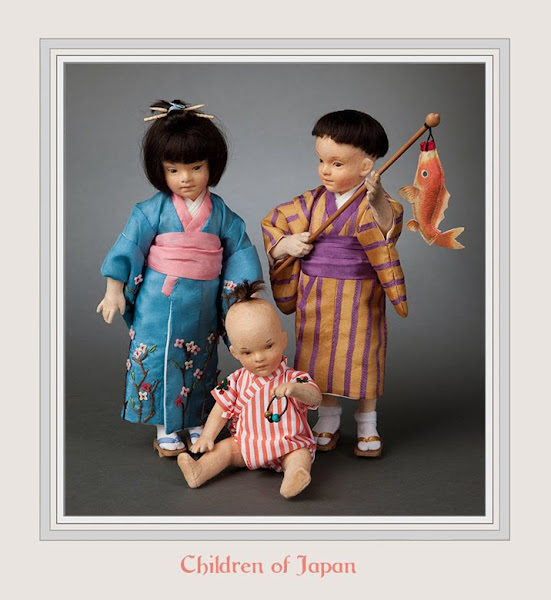

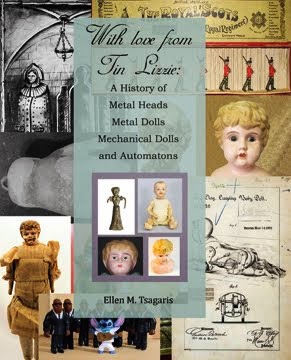
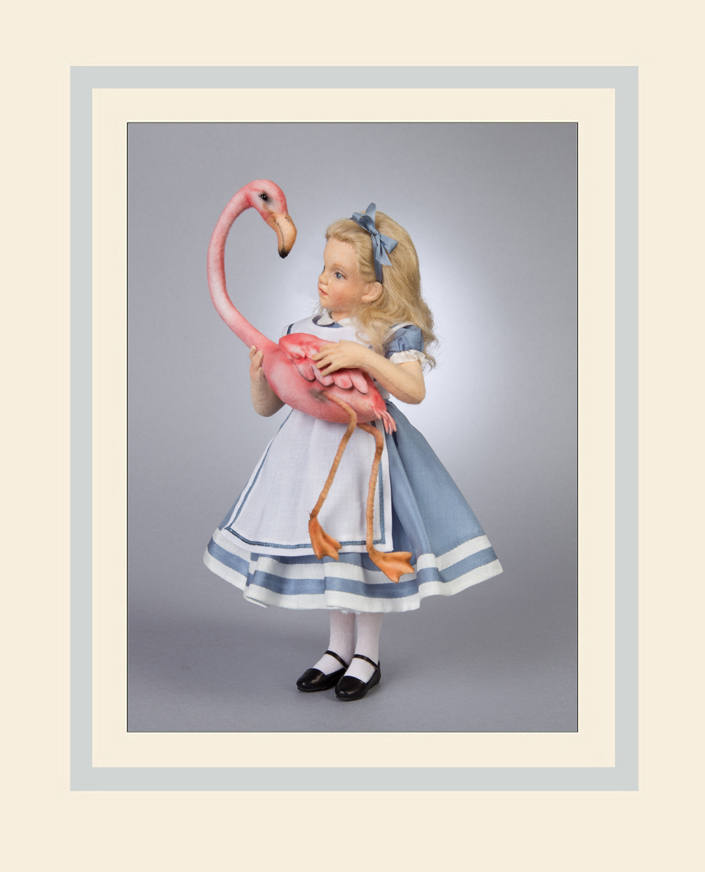


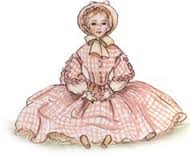


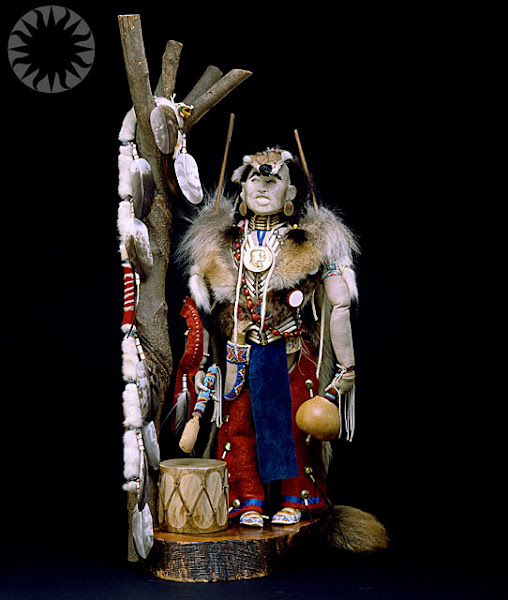
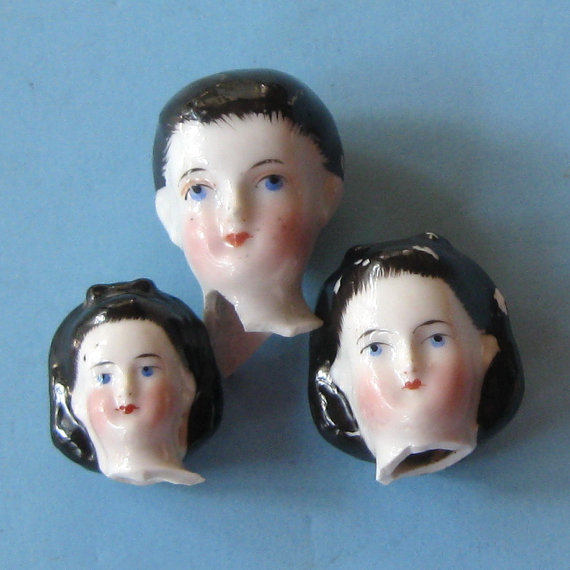
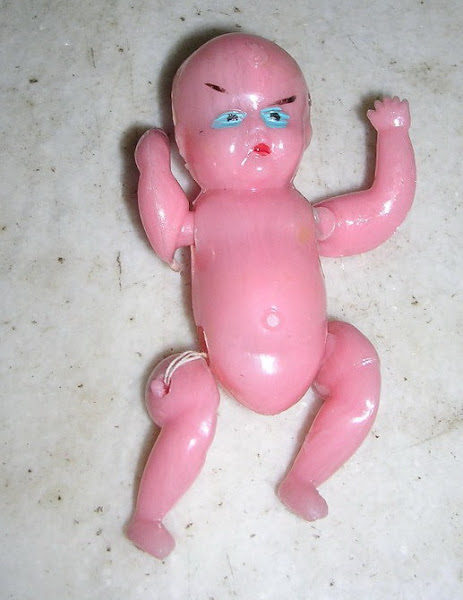
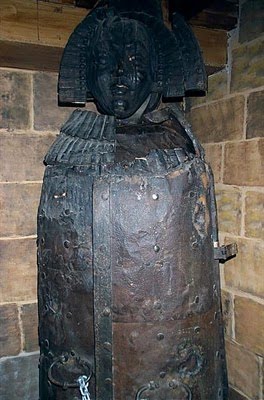

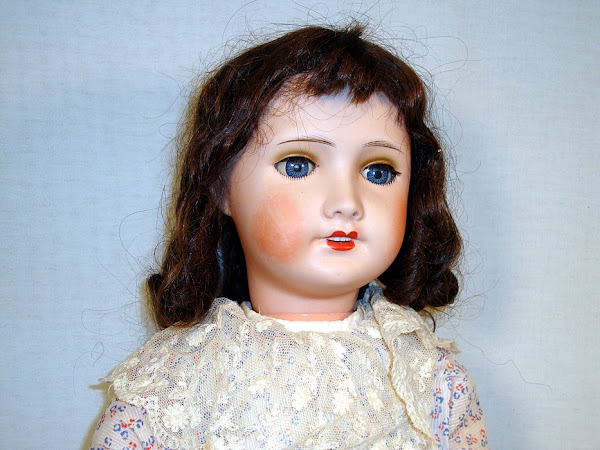



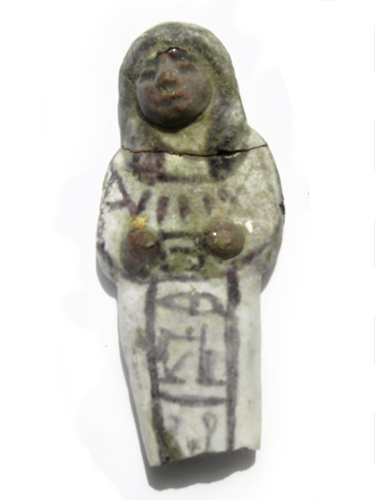
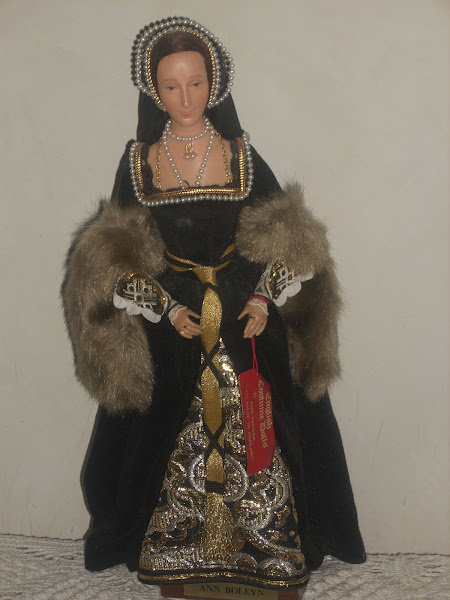





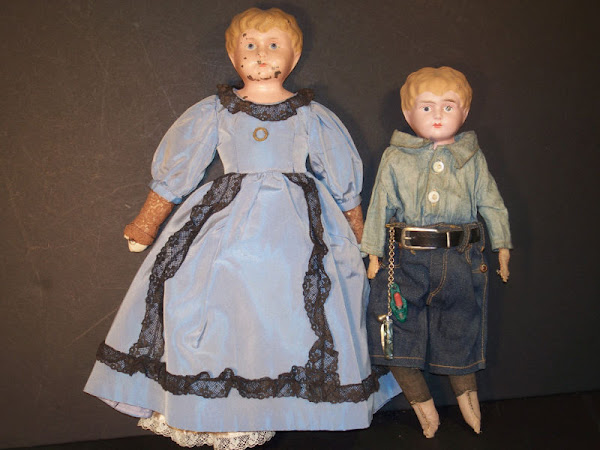


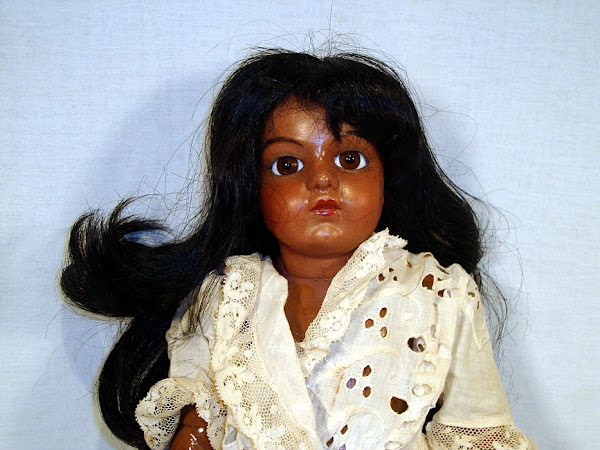
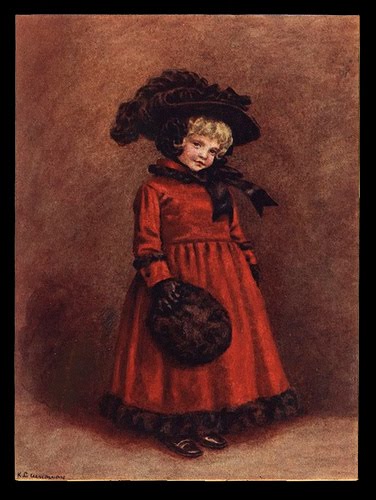

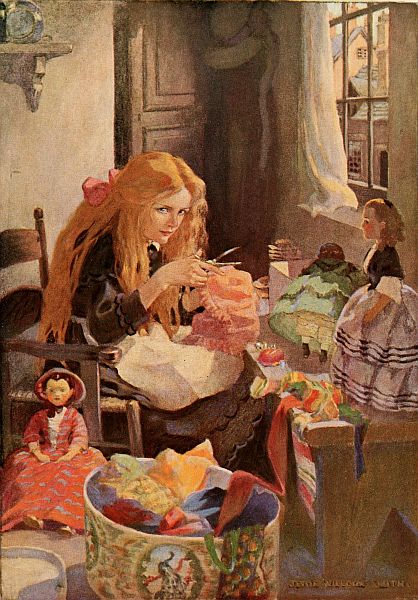


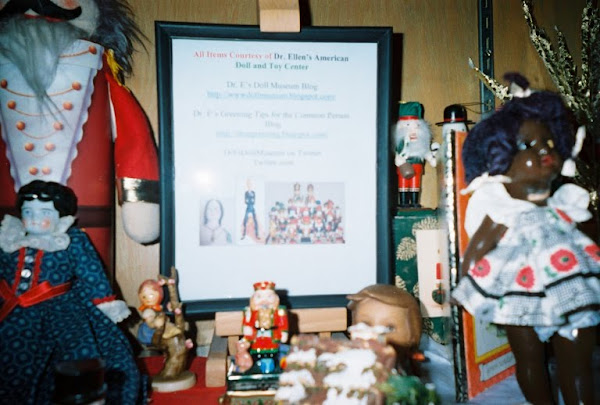






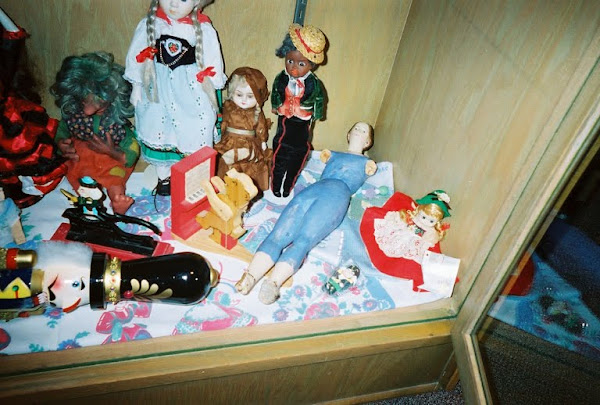
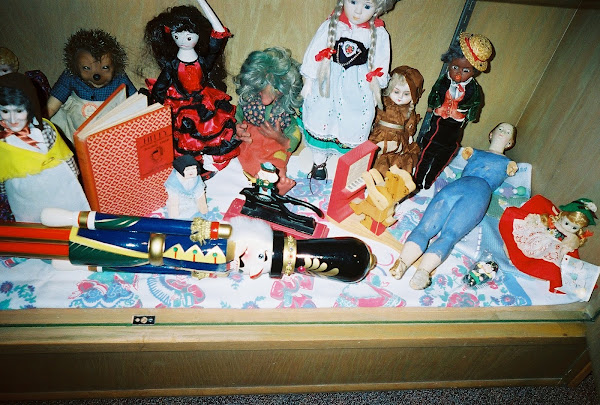
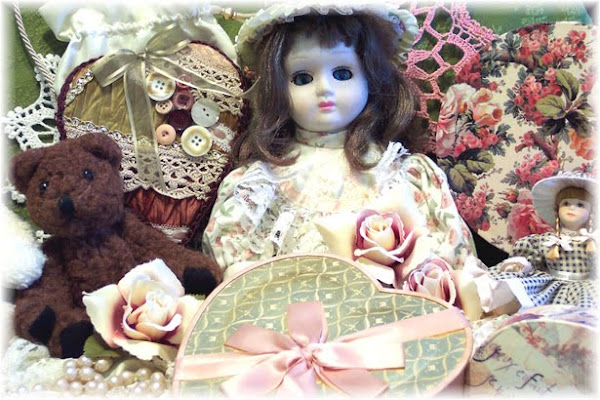
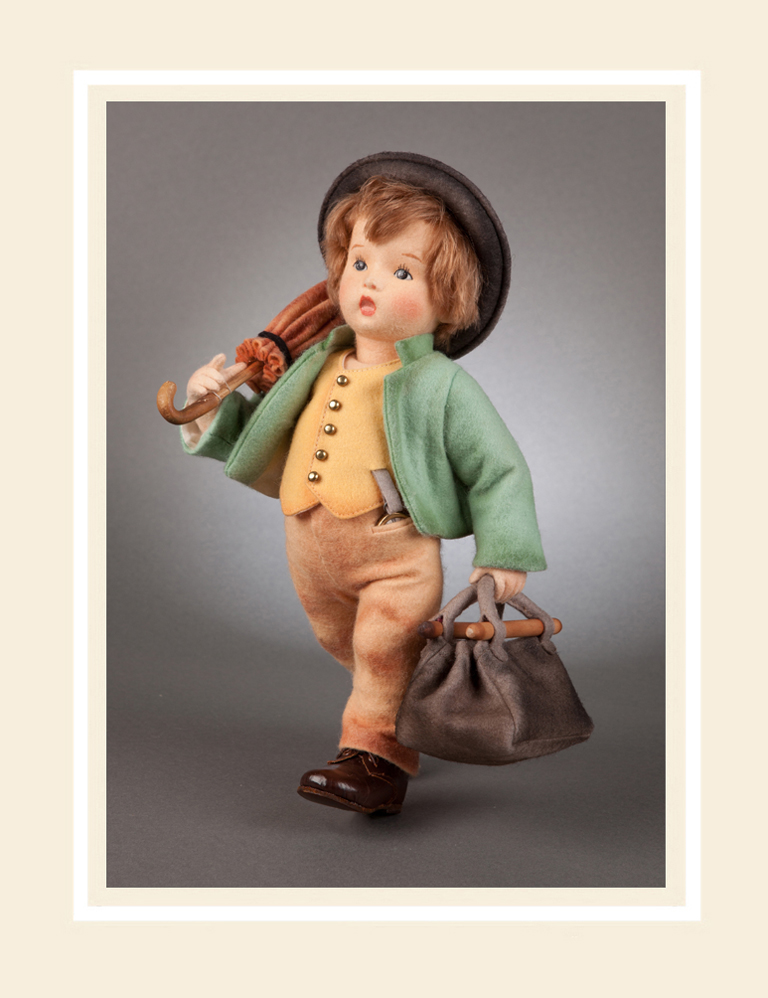

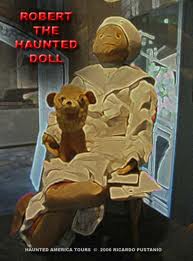

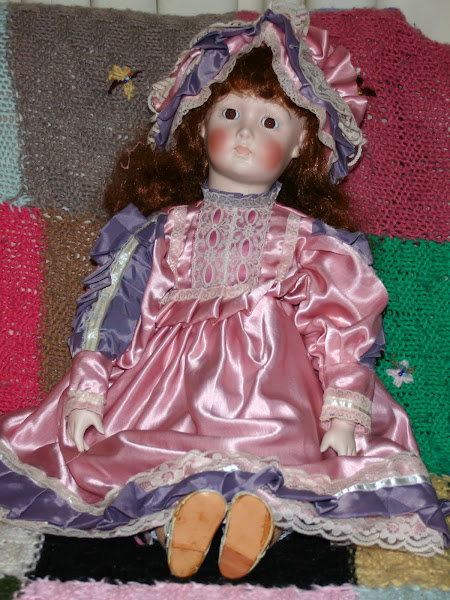
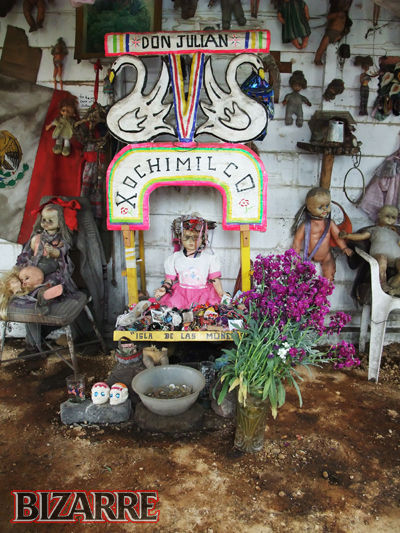
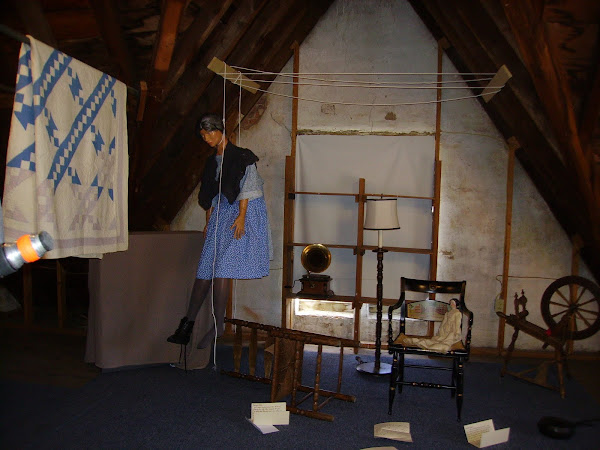
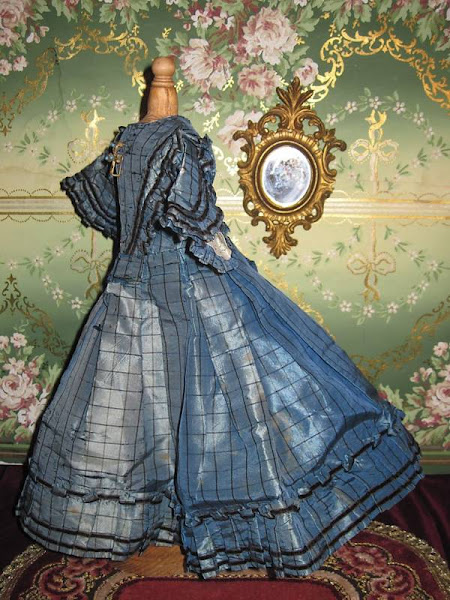wCWk~%24(KGrHqV,!h8Ew5GsnS3dBMUy3MzVPg~~_3.jpg)


